The WSL has been back with us for a good few weeks now, and this fixture saw one of the early form teams, Arsenal Women, travel to former England boss Hope Powell’s Brighton and Hove Albion Women. The game ended 5-0 to Arsenal, but it was not as one-sided as that may suggest. This tactical analysis will look at Arsenal’s defensive tactics, as well as how they looked to push forward in attack when in possession. The analysis will also look at Brighton’s defence in the first and second half, seeing how Hope Powell made tactical changes to help them stem the attacking flow from Arsenal.
Lineups

If we first look at the lineups, Brighton and Hove Albion Women made just two changes from the side that lost 3-0 away to Manchester United Women, with versatile defender Victoria Williams and Republic of Ireland midfielder Megan Connolly both dropping to the bench. In came New Zealand centre-back Rebekah Stott and another Republic of Ireland international, striker Rianna Jarrett, to replace them.
Arsenal Women, meanwhile, made two changes of their own, with Austria captain Viktoria Schnaderbeck relegated to the bench and England midfielder Jordan Nobbs injured. In came Leonie Maier at right-back, and Switzerland midfielder Malin Gut, who made her first league start since her move this summer to Arsenal from Grasshopper.
Arsenal Women’s defence
The first thing we will look at in this analysis is Arsenal Women’s defence, which changed depending on whether Arsenal were in or out of possession.
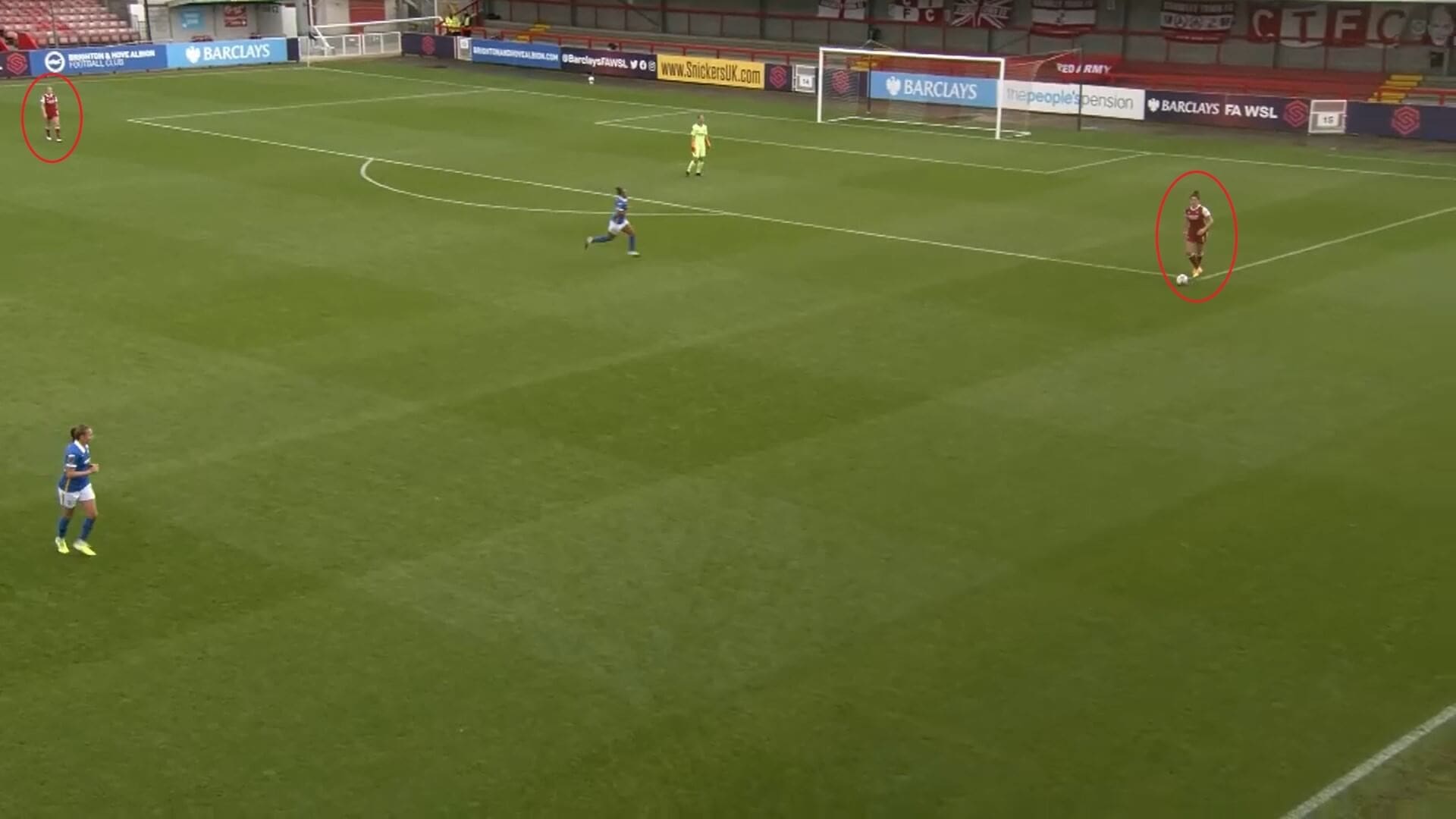
You can see in this image how Arsenal’s centre-backs naturally pushed into the wider positions, stretching the pitch and making it as big as possible. This means that goalkeeper Manuela Zinsberger had plenty of options when she had the ball in her area. This isolates the Brighton and Hove Albion Women attackers, who were often on their own in these situations, as you can see. Therefore, the first thing about this setup was that meant Arsenal could move the ball around Brighton with ease.
The second thing it meant was that Arsenal’s full-backs could get higher up the pitch, offering longer passing options for Zinsberger. This then led to the structure we can see in the image below.
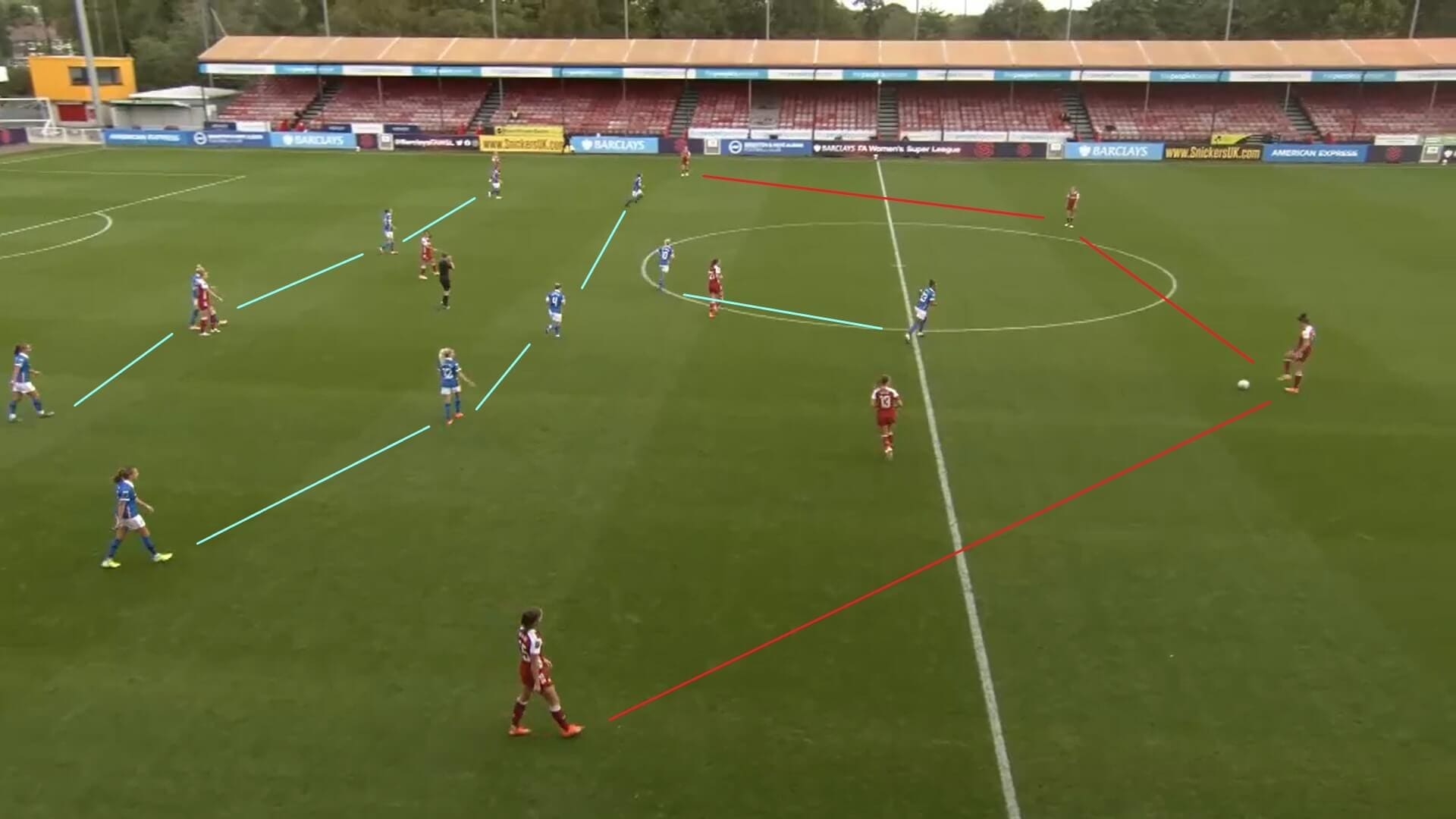
Here, we can see how Brighton have a really narrow structure, with the two ranks and front two marked out by the blue lines. This narrowness means that Arsenal could wrap their defence around the edges, squeezing Brighton together, but also allowing them to create passing options higher up the field. This all came from the centre-backs splitting and the full-backs pushing up the field as a result.
This is what Arsenal did when in possession, but, when they lost possession, they had to track back to protect the open space currently behind them.
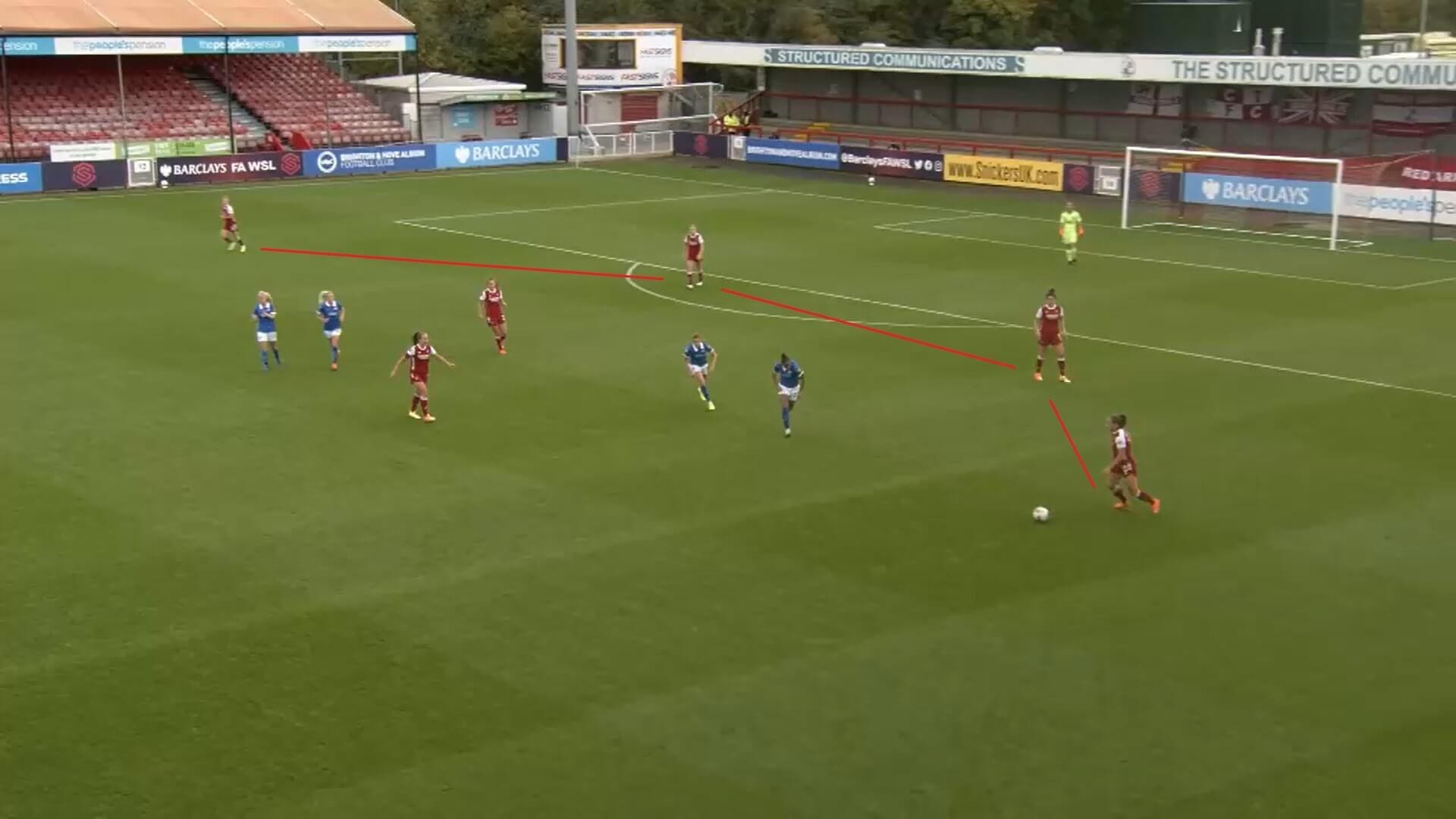
Here, we can see how Brighton have moved the ball towards the Arsenal box, but still have a narrow structure. This means that Arsenal, when they take the ball back, as they have here, can still use the wings to move the ball away from the danger area. Arsenal’s defence has become more centrally focused, compared to the previous image, as they have had to come together to close any gaps between themselves, but you can see how they are still able to stretch apart a little in order to make the pitch as big as they can.
Therefore, these two images have shown us how Arsenal’s defence stretched right across the pitch when attacking, but was then able to transition into a slightly narrower, but still effective structure when Arsenal needed to get back and stop Brighton getting behind them and into the box.
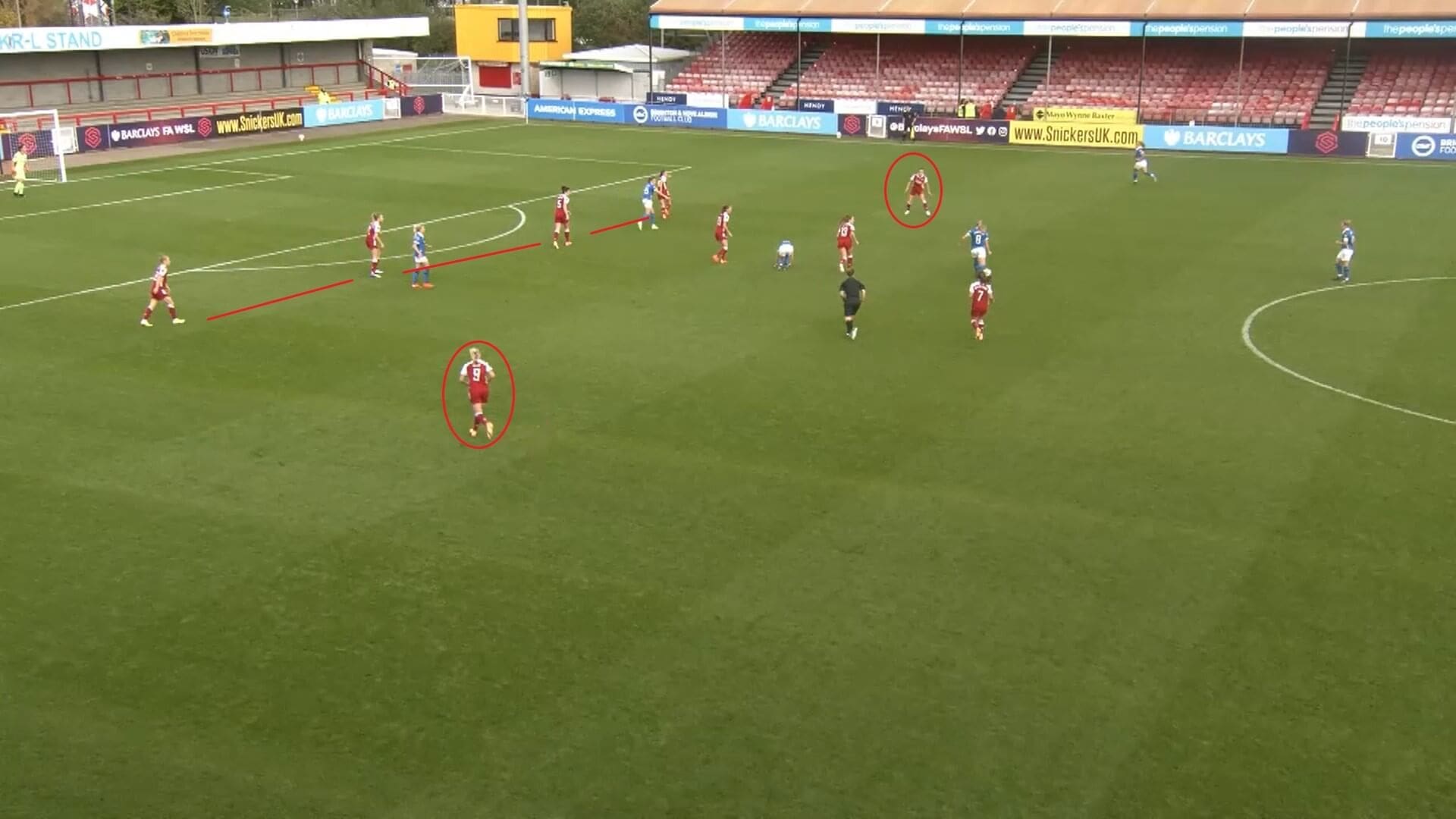
Brighton attacked with more purpose in the second half, and it became necessary for Arsenal to not push their defenders as high, in order to prevent the home side having access to the space behind them. Therefore, the back four became flatter, as we can see in this image, and the wide attackers, Beth Mead and Caitlin Foord, tracked back on either side, as you can see in the red circles. Their job was to protect the wings, stopping the ball getting into those areas, whilst the back four were then able to play together much more. The aim of this was to stop Brighton finding any gaps between the defenders to make a run through.
Brighton were not able to score in the game at all, but did have some chances. However, the main reason they weren’t able to score was because Arsenal’s tactics were adaptable, and they nullified Brighton’s change in tactics in the second half by simply altering theirs.
Arsenal Women’s attack
Arsenal Women were also very clever when attacking, as they looked to wait until Brighton gave the ball away, before pouncing and all getting forward. We can see in the image below how they set up to stop Brighton moving out of their half.

Here, Foord is the only player in an attacking position, with the other five midfield players sitting back in a straight line. We know Foord can play in these central positions, and it is important that she does this, because Vivianne Miedema, their usual centre forward, can and does drift into the wider areas; here, she is the player on the nearside wing. In terms of versatility in the Arsenal team, this is an important point to make.
However, the main thing about this is that Brighton can’t find a way through into Arsenal’s half. Therefore, they are forced to pass the ball around, until Arsenal manage to tackle them and win the ball.
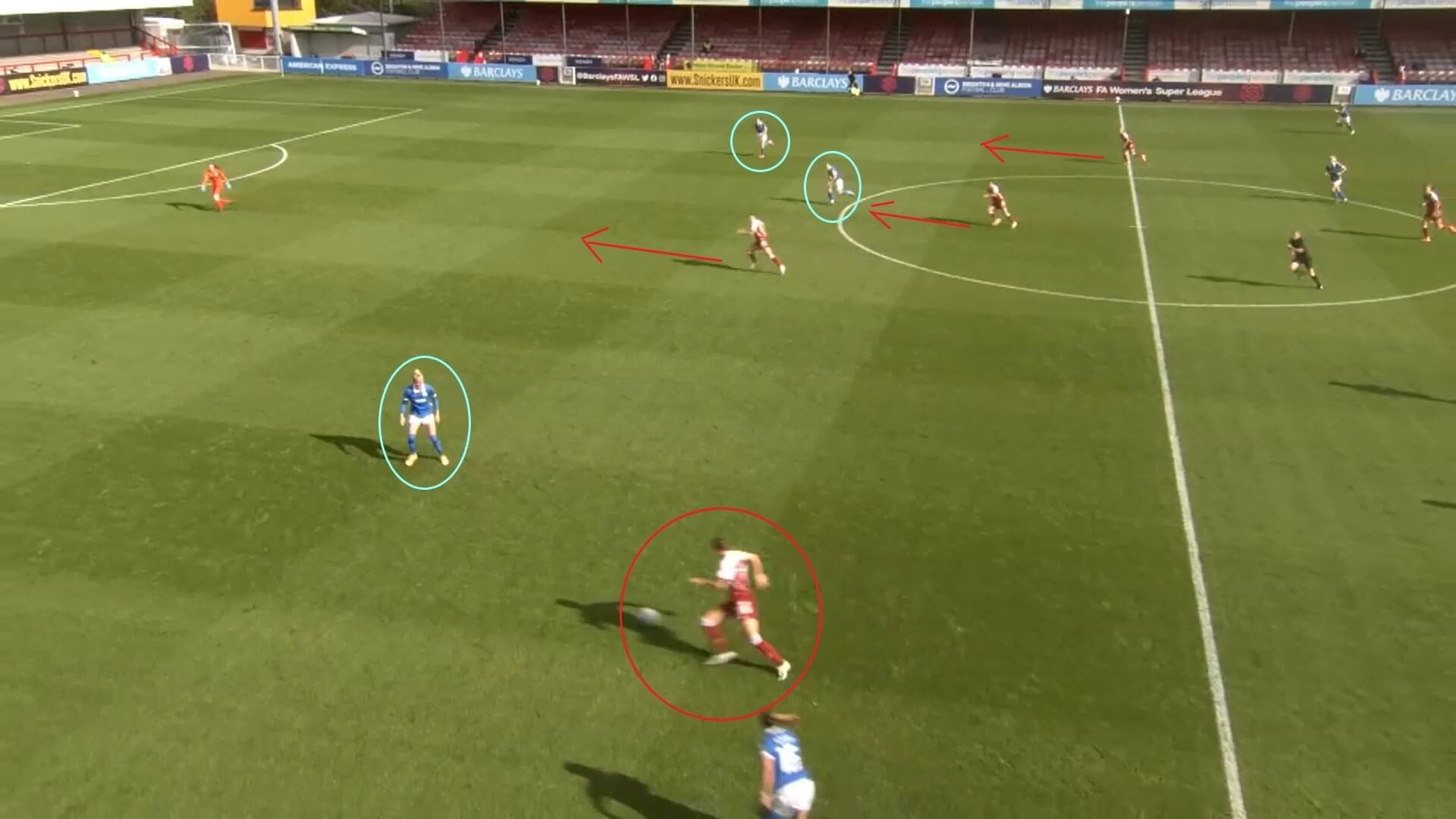
At this point, Arsenal’s attackers move forward, as we can see here from the red arrows. Brighton are now outnumbered by four to three in their half, and Arsenal have options to move the ball too. Therefore, we can see how Arsenal were patient, and waited for the right moment to take the ball and all run forward.
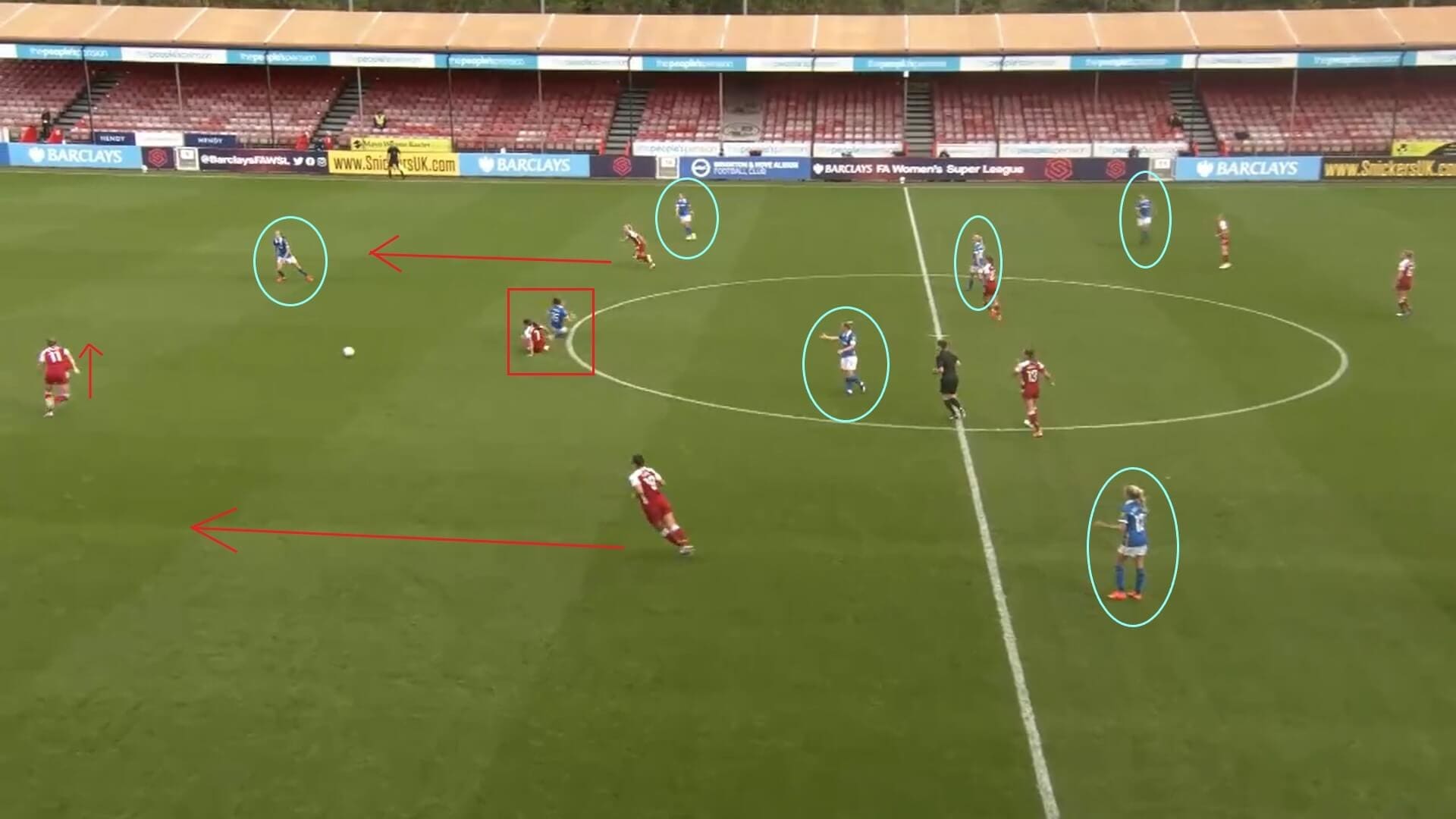
This image shows another example of Arsenal all getting forward once they had won the ball. All the Brighton players in the image are in blue circles, and you can see how the majority are behind the Arsenal attackers, meaning that they will struggle to get back and help defend.
We can see as well how the two wingers have again moved backwards to help out, but as soon as Danielle van de Donk makes the challenge on the Brighton defender, and the ball gets forward, Vivianne Miedema moves to meet it, and Beth Mead and Caitlin Foord get into the wide areas, ensuring that Arsenal’s attack stretches across the pitch. This means that they have good passing options in the wide areas, and gives Brighton a dilemma, because their limited defensive numbers now have to mark the wingers or stop Miedema getting through them centrally.
Therefore, we can see how Arsenal were constantly switched on, and knew their roles and where to go once one of their players won the ball.
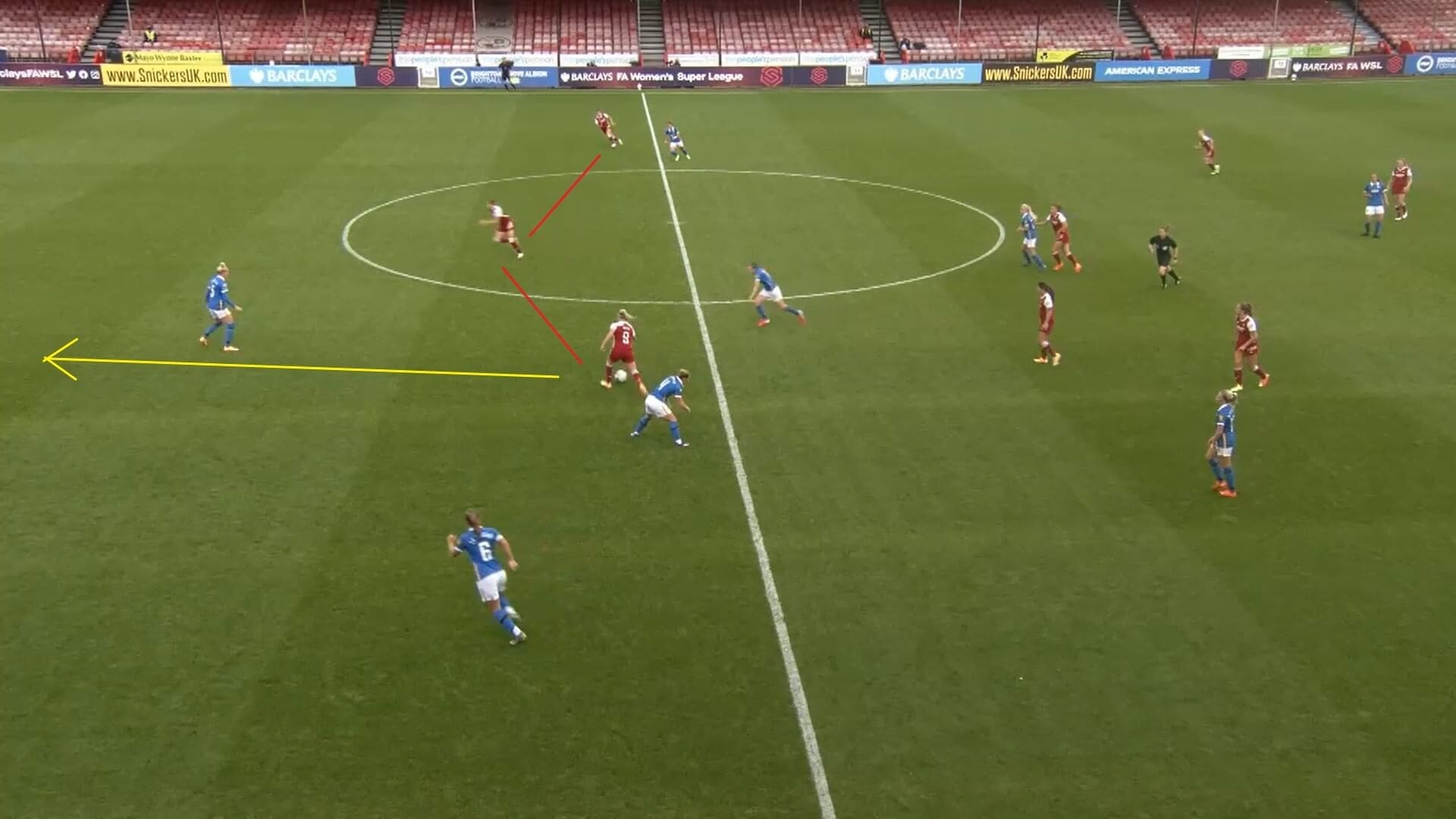
We mentioned how the wide forwards, Beth Mead and Caitlin Foord, were in tune with Vivianne Miedema, all working together as a front three. In this image, we can see more clearly how they worked together to get the ball into forward areas as quickly as possible. Beth Mead has claimed the ball here, and her first thought is to make the pass forwards, as the yellow arrow shows. Miedema, who is in the middle, instinctively runs forward to meet it, and would have likely scored, had it not been for an excellent save from Brighton goalkeeper Megan Walsh. This shows the same tactics of all going together when they win the ball, but in a different way.
Brighton were constantly caught in these situations, because they were playing with a high backline a lot of the time. As we can see in this image, one tackle isolates Brighton centre-back Danique Kerkdijk, and the pass forward from Mead then ensures she can’t affect the play, with her international teammate Miedema then able to get past her to meet the ball. Therefore, whilst it was good incisive play from Arsenal to create the chance, Brighton’s high defensive line constantly allowed these opportunities to happen.
Brighton and Hove Albion Women’s defence
These errors will now form the next part of our analysis, which will focus on Brighton and Hove Albion Women’s first half defence, and how they changed its tactics in the second half.
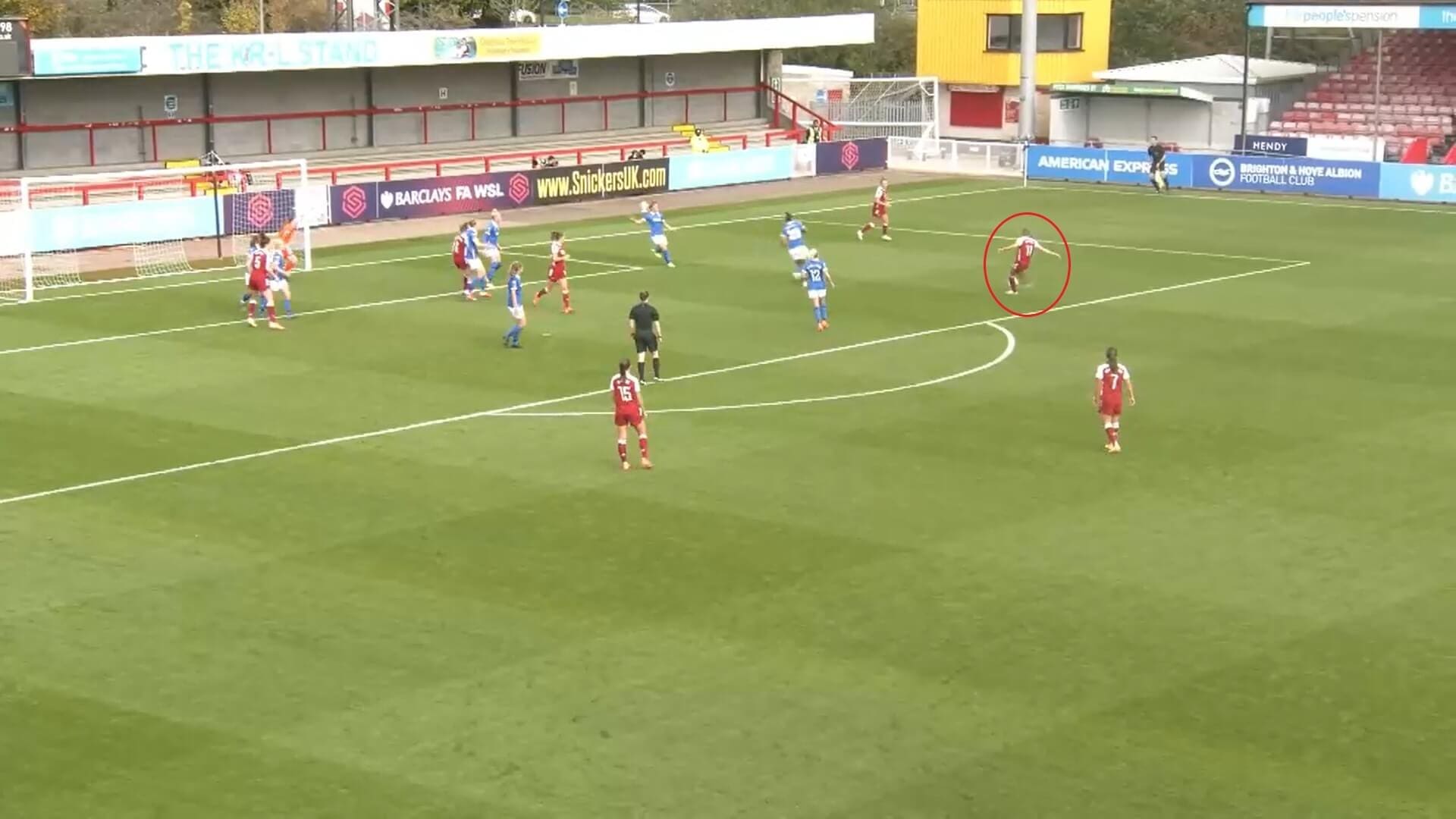
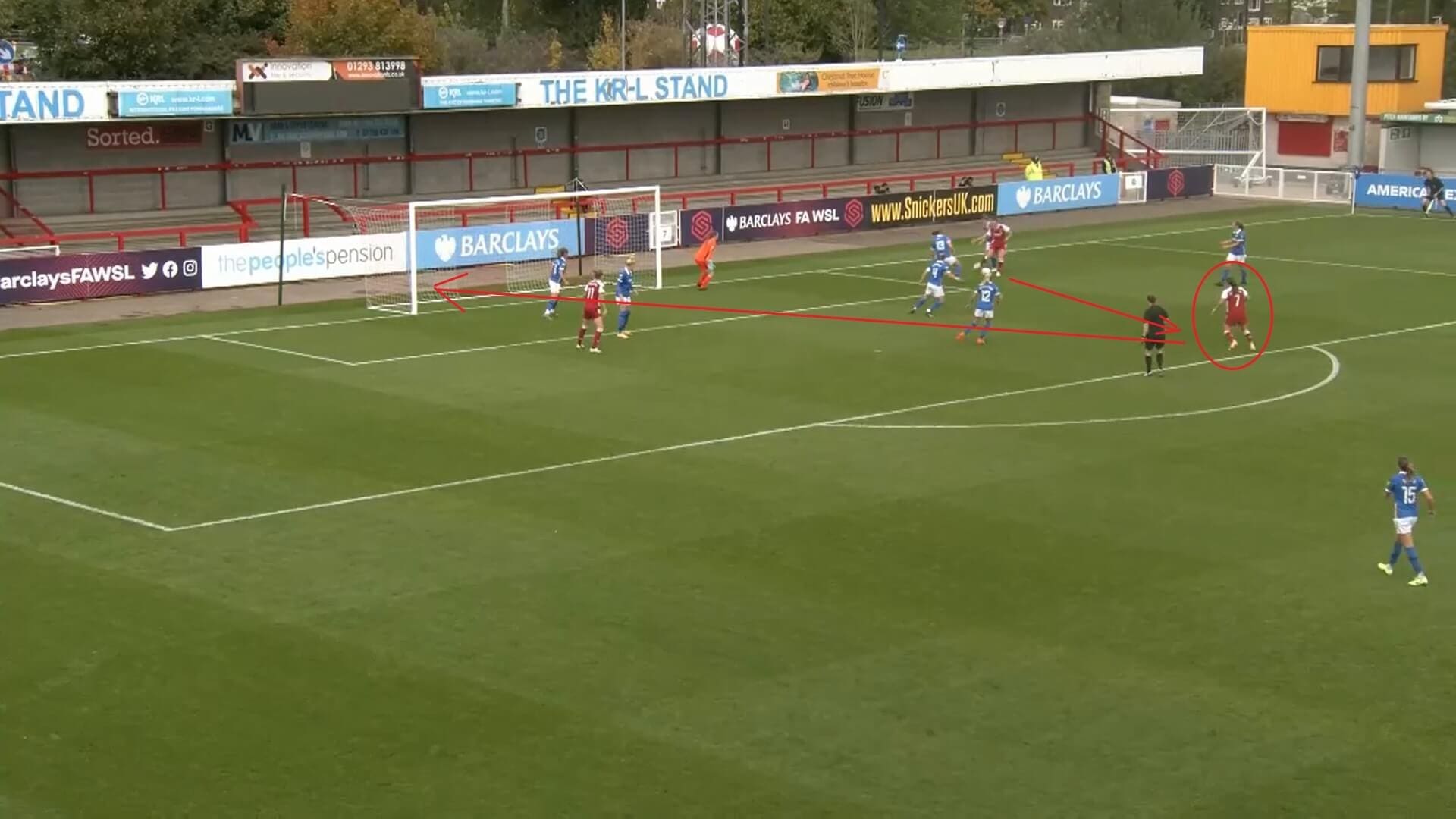
If we look at these two images, we can see the same thing happening; Arsenal Women have a player on the edge of the box, and aren’t being picked up by any Brighton defenders.
In the first image, Vivianne Miedema has the ball, and is taking a shot at goal. This time, it went just over the bar, but this was a warning for Brighton, because they were hesitant in getting out to the Netherlands striker and closing her down, stopping the shot.
However, it is a lesson they didn’t learn from. In the second image, we can see Danielle van de Donk in the same position, but this time, as the arrows show, she scores Arsenal’s second goal of the game. The first red arrow shows you that the pass to find her came from the wing, and was then pulled back towards her. Therefore, Brighton had two opportunities here to stop the goal being scored, but a lack of urgency in both situations meant that they didn’t.
In the second half, Brighton got closer to Arsenal, stopping them playing forward with as much freedom.
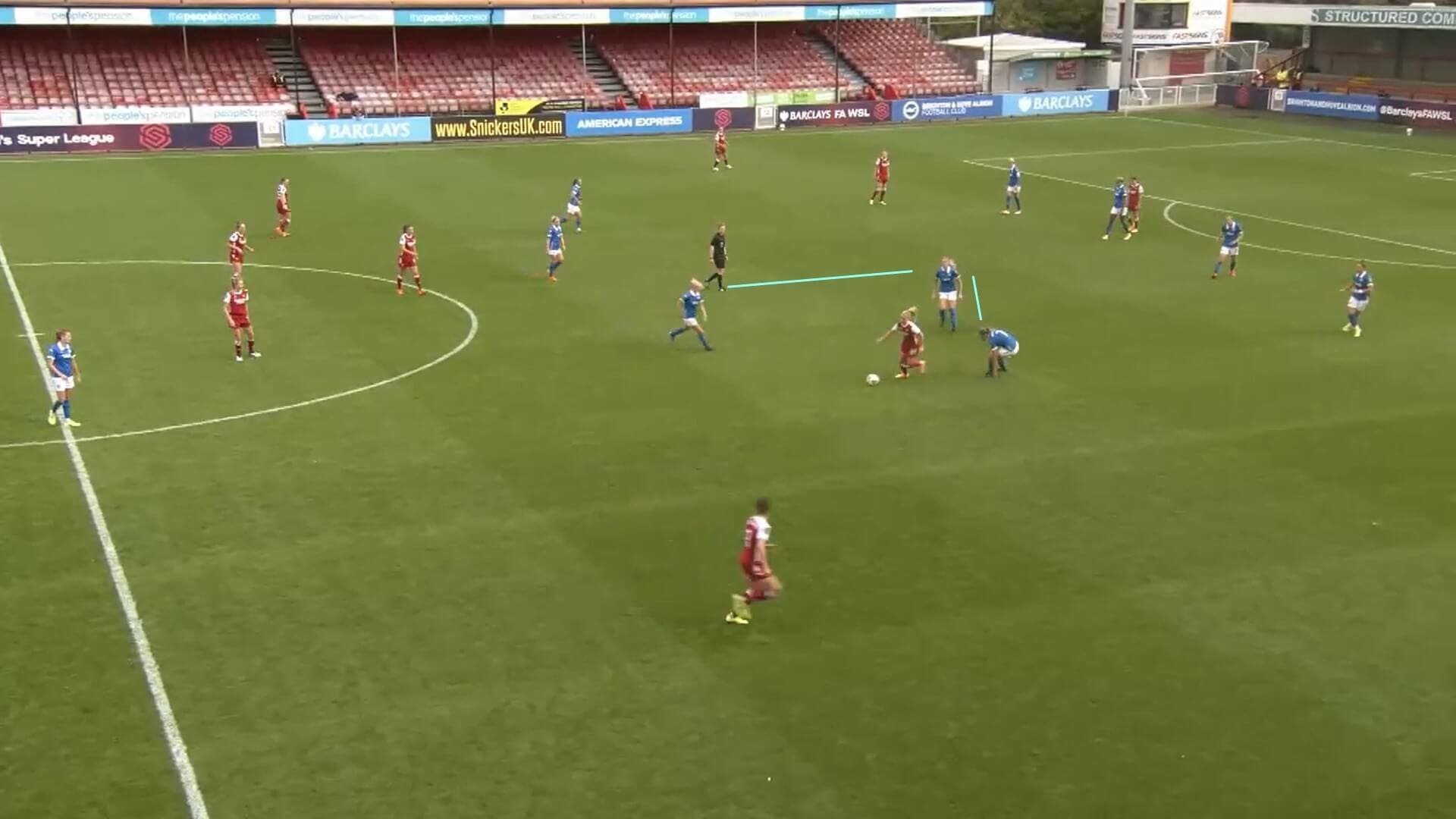
Here, we can see how Arsenal have advanced into an attacking position, but Brighton have more players back, meaning there is not as much space for Arsenal to move the ball and players into.
This also meant they could press Arsenal, forcing them to move backwards. This image shows three Brighton players all crowding around the Arsenal player, meaning that there is nowhere for her to go. This wasn’t possible in the first half, because the players weren’t there to make this possible, but a tactical change meant that they could.
The other thing that Brighton did more in the second half was to sit back in a straight line in defence, ensuring that the space behind, and their goal area, was well defended.
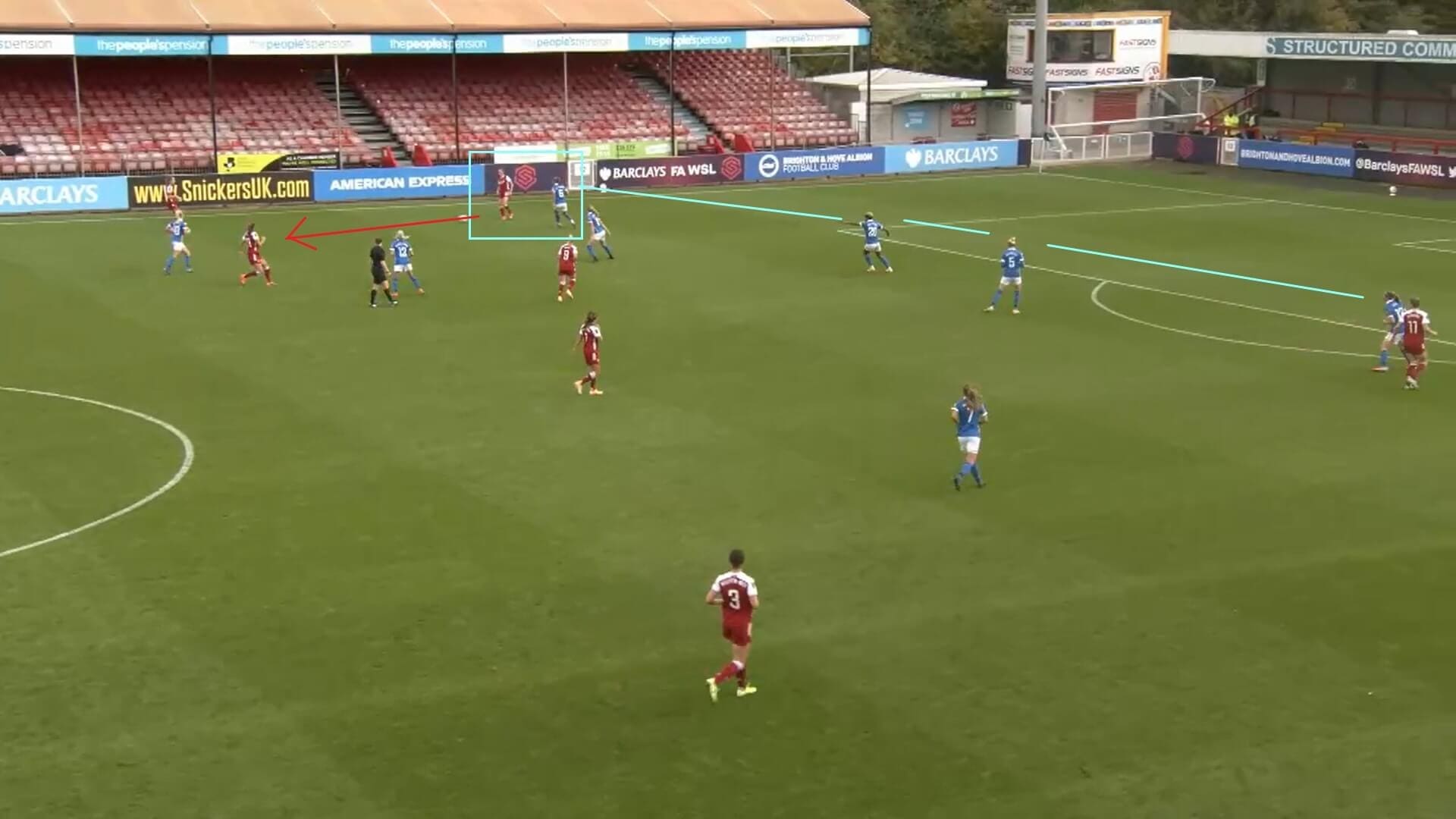
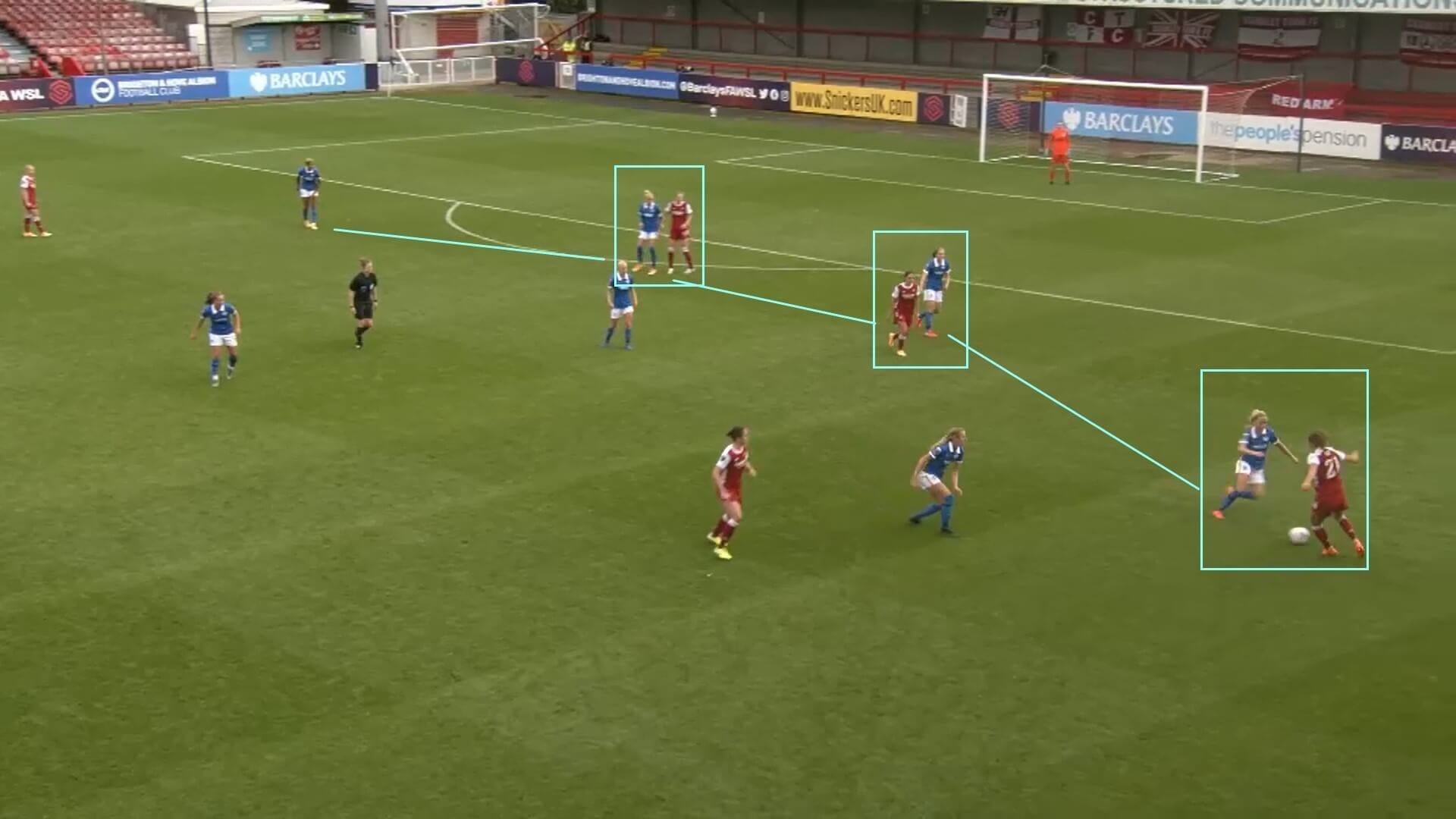
In both of these images, we can see how Arsenal are trying to attack on the wings, but are being closed down by the Brighton defender on that side of the pitch. If we remember in the first half, Arsenal had open space in the wide areas, with Beth Mead and Caitlin Foord able to get up and down the pitch with relative ease. Now, however, they couldn’t do that, and this is another way that Brighton changed their defensive tactics to keep Arsenal out.
In the first image, we can see how Brighton right-back Maya Le Tissier has moved out to the wing, leaving a gap between her and her teammate. However, that doesn’t matter, because there is no way the ball can get into that area. Instead, as the red arrow shows, Arsenal have to play it backwards. You can see as well how Vivianne Miedema is on the nearside of the pitch, a good distance away from the ball, and there are no Arsenal players looking to get behind the defensive line. This is because they know that the ball can’t go forwards into the space, only backwards to where they are now.
In the second image, we can see how Arsenal are again looking to attack down the wing. However, they are unable to do so, with all three of Arsenal’s forward players being closed down by a Brighton defender, as the boxes show. Therefore, again, there is no option to get the ball into the area behind the defence, and it must go backwards.
Arsenal’s goals in the second half came from a corner and two close-up finishes, but none from the edge of the box or outside the box. This was because Brighton had given them no option to shoot from these areas, unlike in the first half, when we saw how they were able to do so. This is how Brighton’s tactical improvements in the second half changed the game.
Conclusion
In conclusion, Arsenal Women may have won 5-0 in this game, but it was not a simple one-sided contest. We have shown in this tactical analysis how their first half strength was to constantly adapt their tactics to ensure they always had the upper hand on Brighton and Hove Albion Women, but in the second half, Brighton altered their defensive tactics, enabling them to stop Arsenal attacking so freely. Arsenal will be pleased to keep their 100% streak up, and currently sit top of the WSL, just ahead of Everton Women, who have also won four out of four league games this season. Next up for Brighton is a trip to Everton, whilst Arsenal host the first North London derby of the season.





Comments